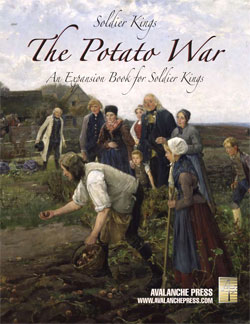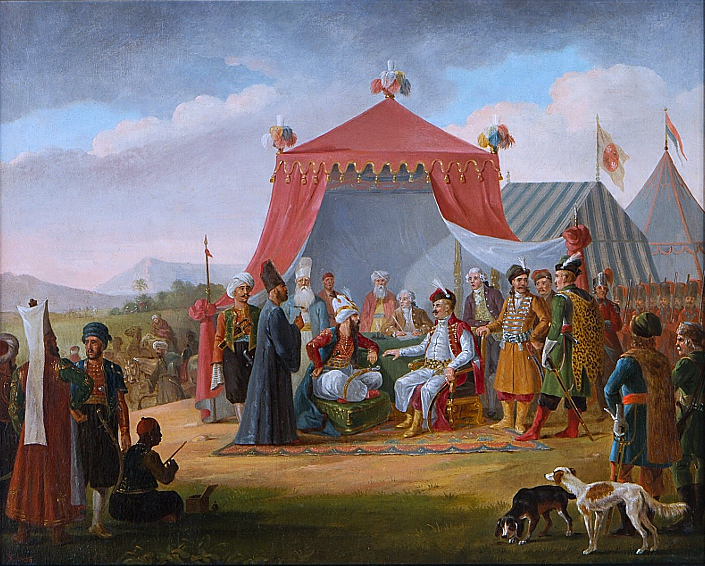The Potato War
The Russo-Ottoman War Begins
by Mike Bennighof, Ph.D.
March 2018
 The massacre began in the open fields just to the east of Balta, a border town on the Kodyma River separating Turkish and Polish-ruled territory. Ukrainian Cossacks in Russian pay known as haidamaks had attacked the Polish city of Uman in mid-June 1768. They undertook a bloody pogrom, slaughtering at least 2,000 Polish and Jewish residents (one haidamak leader claimed 33,000 dead, which at several times Uman’s population at the time seems improbable). The massacre began in the open fields just to the east of Balta, a border town on the Kodyma River separating Turkish and Polish-ruled territory. Ukrainian Cossacks in Russian pay known as haidamaks had attacked the Polish city of Uman in mid-June 1768. They undertook a bloody pogrom, slaughtering at least 2,000 Polish and Jewish residents (one haidamak leader claimed 33,000 dead, which at several times Uman’s population at the time seems improbable).
Surviving Jews fled across the Kodyma into Turkish territory. The Cossacks followed, killing hundreds more as the refugees straggled into Balta, a border fortress manned by a company of Turkish janissaries. Mixed with the fleeing Jews, the haidamaks stormed the fortress gates before the guards could close them, and proceeded to kill not only the refugees but any other Jews resident in Balta they found.
The Turkish agha commanding the janissaries ordered his troops to drive the invaders out of the city, and house-to-house fighting erupted as the Turks steadily forced back the haidamaks, who eventually broke and fled into the open. There a Tatar cavalry regiment summoned by the agha finished them off, and apparently also looted the bodies of the slain refugees. In addition to hundreds of Polish subjects killed by the haidamaks, upwards of 1,000 Jewish residents of Balta were also slain.
 The agha’s report enraged Sultan Mustafa III Yenilikci (right) and his divan of senior officials. Subjects of the Sultan had been murdered by minions of the Russian Empress. Those Russian minions had also forced their way into a Turkish fortress-city and engaged uniformed Turkish soldiers – janissaries no less, slaves of the Sultan – in a prolonged firefight. There could be only one response. There would be war. The agha’s report enraged Sultan Mustafa III Yenilikci (right) and his divan of senior officials. Subjects of the Sultan had been murdered by minions of the Russian Empress. Those Russian minions had also forced their way into a Turkish fortress-city and engaged uniformed Turkish soldiers – janissaries no less, slaves of the Sultan – in a prolonged firefight. There could be only one response. There would be war.
After nearly three decades of peace, the Ottoman Empire had been drifting towards war with Russia over Empress Catherine’s meddling in Poland. Despite French and later British urging (and bribery), the Turks had peacefully sat out both the War of the Austrian Succession and the Seven Years’ War. Mustafa had hoped to use a prolonged period of peace to modernize his empire’s military and financial machinery, but recent Russian moves in Poland and elsewhere seemed likely to upset the balance of power in Eastern Europe.
Russian armies had repeatedly crossed Polish territory during the Seven Years’ War, and when Russia withdrew from the conflict in 1762 they left Poland but Russian armies remained close by: the new Tsar, Peter III, planned a war of conquest against Denmark. Peter, also the Duke of Holstein-Gottorp via his father, wish to expand his duchy using his newly-inherited Russian regiments. The Tsar never got his war; a coup removed him from power before the troops marched and he both mysteriously and conveniently died soon afterwards.
His wife seized the throne as Empress Catherine II, and immediately ended the plans for a Danish invasion. War with Denmark would bring Russia little profit, she believed, and potential economic devastation by cutting off trade through the Baltic Sea. It also represented one of her late husband’s key ambitions, and she had no desire to fulfill any such plans.
After soothing relations with Denmark, Catherine and her advisors developed a plan for a so-called “Northern Accord” that would bring Russia, Prussia, Britain, Denmark and Poland into a political and economic alliance. Some Russian diplomats feared that the French would convince their Austrian allies to drop their ancient distrust of the Ottoman Turks. A combination of France with her new ally Austria and her old ally Turkey would create a dangerous power bloc opposed to Russian interests.
Including Poland in the Accord marked a shift in Russian policy, which had long sought to control the ramshackle kingdom and its elective monarchy. As King August III “The Fat” of Poland neared death, Catherine expressed a desire for a native Polish king rather than a foreign prince like the ineffectual Augustus (who also held the Electorate of Saxony). She soon made her selection: Stanislaw Poniatowski, her onetime lover and a member of the Czartoryski family, perhaps the most influential in Poland. The new Russian approach called for a much stronger Poland that could hold up its part in the new alliance.
Stanislaw took the crown in 1764 thanks to massive Russian bribery and the presence of 14,000 Russian troops in Poland, despite French attempts to find a more pliable, anti-Russian rival. The new king hoped to centralize Poland’s financial structure, abolish the liberum veto by which any single member of the Polish Parliament, the Sejm, could veto legislation, and finally to raise a professional Crown Army of 50,000 men answerable directly to the king in place of the private armies of the Polish magnates and the tiny royal forces.
The Russians, meanwhile, had increased their troop strength in Poland to 40,000 men. Nikolai Repnin, Catherine’s ambassador to Warsaw and thereby de facto viceroy of Poland, refused to allow the king to expand his army without certain concessions. Poland must enter into a formal military alliance with Russia. The liberum veto must be retained, therefore making the king and Sejm once again utterly powerless. And Stanislaw must publish an edict of toleration, allowing non-Roman Catholics – meaning Russian Orthodox believers - into government posts including the Sejm. Catherine had apparently changed her mind regarding a strong Poland.
Repnin made his demands in the summer of 1767, and the subsequent session of the Sejm devolved into sharp factional bickering. The Catholic faction began sounding out Sultan Mustafa’s government regarding possible aid in case of rebellion against the Russian occupiers, an issue that had always concerned the Turks. They also approached the Austrian government to seek a pledge of neutrality in case Turkish troops did intervene in Poland.

Bar Confederates meet with Turkish representatives while dogs observe, 1768.
In February 1768 Repnin pushed a law through the Sejm acceding to all three demands. Three hundred Polish nobles gathered at Bar in Podolia, near the Turkish border, to form a confederation. Polish law and tradition upheld a “right of rebellion” against central authority, giving legal protections to a confederation that met the norms of formation (the confederates would issue a written declaration of their grievances, lodge it with the local court, and all would swear to their agreement with the document).
The Confederation of Bar began to gather troops, under the leadership of Col. Kazmierz Pulaski, gathering men from the Crown Army and the private regiments of the large landowners. The Confederates recruited throughout the summer and autumn of 1768 and skirmished with the Russians. Despite Repnin’s demands, Stanislaw hedged and stalled rather than deploy the tiny Crown Army.
In early October the Grand Mufti issued a fatwa declaring that since innocent Muslim blood had been shed, war with Russia had religious justification. On 6 October Sultan Mustafa ordered the Russian ambassador tossed into a dungeon, the traditional signal that war had been declared. On hearing the news, the Confederation of Bar issued a Manifesto calling on all of Poland to rise against the Russians.
Catherine now faced wars in Poland and on her southern frontier. The Empress was no doubt very pleased with these developments: the path was open to the wars of conquest she had hoped to wage, with her enemies cast in the role of aggressor.
Note: Our Soldier Kings: The Potato War expansion book is built around two conflicts that took place in the latter half of the 18th century: the Russo-Ottoman War of 1768 and the Potato War of 1778.
Click here to order The Potato War right now.
Mike Bennighof is president of Avalanche Press and holds a doctorate in history from Emory University. A Fulbright Scholar and award-winning journalist, he has published over 100 books, games and articles on historical subjects.
He lives in Birmingham, Alabama with his wife, three children and his dog, Leopold.
|
